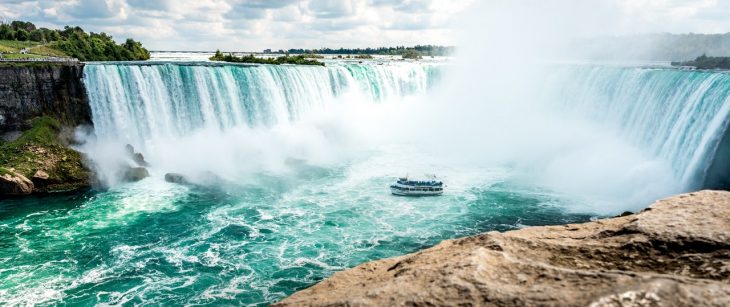
As one of the most distinct borders between Canada and the US, the Niagara Falls serves as a meeting point of different cultures. Since the time of the early Native American settlers, this natural water formation has played a vital role in history. For its great rapids, the Niagara Falls also gained a reputation for its natural beauty. As such, it is also one of the most protected landmarks in the world. Find out more about one of the world’s most famous natural landmarks with these amazing Niagara Falls facts.
- Niagara Falls consists of 3 drops in total.
- This Niagara Falls waterfall has a drop that measures 167 feet or 51 meters.
- The average flow rate of Niagara Falls is at 85,000 cu ft/s or 2,400 cubic meters per second.
- Niagara Falls can be found 27 km north-northwest of the border of Buffalo, New York.
- Niagara Falls lies 121 km south-southeast of the border of Toronto, Canada.
- Niagara Falls is located in the southern end of Niagara Gorge in Ontario and the state of New York.
- The largest waterfall in Niagara Falls is the Horseshoe Falls which is also known as the Canadian Falls.
- The smaller waterfalls of the Niagara Falls are the American Falls and the Bridal Veil Falls.
- The Horseshoe Falls is also considered to be the most powerful waterfall in North America by flow rate.
- Niagara Falls was formed from glaciers that receded at the end of the Wisconsin glaciation.
- The water from Niagara Falls leads towards the direction of the Atlantic Ocean.
- Niagara Falls is also valued as a great source of hydroelectric power.
- Niagara Falls are commonly used for industrial, commercial, and recreational activities and projects.
- Niagara Falls were recorded to freeze over once on March 29, 1848.
- Some of the waterfalls of the Niagara Falls have hidden caves behind them.
- Niagara Falls is considered to be a popular tourist destination in the United States due to its beauty.
- Around 30 million people visit the attraction each year.
- Several bridges have been established around the vicinity of Niagara Falls.
- The deepest point in Niagara Falls can be found below Horseshoe Falls, recorded at 167 feet.
- Tourists and visitors cannot swim around the vicinity of Niagara Falls for safety reasons.
The word Niagara comes from an old Iroquois Indian word.
The name for this famous collection of waterfalls comes from the Indian word Onguiaahra, which translates to The Strait in the English language. This definition references its structure as a bisected bottomland, while other translations can mean ‘thunder of the water’ as well.
Aside from this, there have also been many legends of how the landmark received its name. The most popular and common version often points its origins from the way water cuts through the land.
During the night, multiple different colored lights brighten up the Niagara Falls.
Right after the sun sets on special scheduled days, multicolored lights transform the site into a beautiful illuminated masterpiece. This effect is achieved through special lights housed in the Illumination Tower on the Table Rock Center.
Provided by the Niagara Falls Illumination Board, these lights have been active since 1925. Additionally, the site also has an updated schedule on when people can come to see the special light show that the attraction has to offer. Now, there’s one for Niagara Falls facts that you’d want to witness for yourself.
The noise from Niagara Falls is equivalent to 4 billion people talking into your ear.
One of the little-known Niagara Falls facts is that its rushing rapids make a sound equal to the volume of a lion‘s roar. On average, the running water from Niagara Falls is said to be so loud that it could be heard from over 45 kilometers away.
Some beliefs also suggest that the Niagara Falls used to help Native Americans determine the approach of bad weather coming their way. Throughout history, explorers have also described the sound of the running water from Niagara Falls to be so loud that people couldn’t hear each other speak within it.
Frederick Law Olmsted designed the Niagara Falls State Park.
During the conceptualization of the Niagara Falls State Park, Frederick Law Olmsted wanted to incorporate the same concept as Central Park in New York City. Above all, Olmsted believed that national parks should be places of nature where people could unwind and be renewed.
To this day, the Niagara Falls State Park continues to maintain this very same vision that Olmsted incorporated. With its natural beauty, it remains one of the top tourist destinations in the United States of America. The Niagara Falls State Park includes several facilities that visitors can enjoy, including an entire network of footpaths that allow people to explore the area and appreciate the location for all its wonders.
The films Niagara and Superman were partly filmed at the site itself.
Throughout the years, several old and modern films have been filmed at the site of Niagara Falls itself. These features also include other famous films such as Bruce Almighty, Pirates of the Caribbean: At World’s End, Sharknado 2, and many more movies and shows.
Those who are familiar with the site can often spot the location easily in films and television shows, but those who are not might find it a bit more difficult to identify.

As of 2015, the erosion rate of Niagara Falls reaches 1 foot per year.
Among environmentalists, there is a common concern regarding the erosion rate of Niagara Falls due to it slowing down over the last 50 years or so. Over the years, the average erosion rate of Niagara Falls has been recorded at an average of 3 feet per year, for a total of 11.4 km over the last 12,300 years.
These erosions are caused by the result of the rush and flow of the water where weaker pieces of rocks are being carried away by the current of the falls. Additionally, the constant freezing and thawing of the rocks in winter and spring washes away minerals which could strengthen the rocks that surround the area.
Gymnasts used to perform high wire stunts across the Nagara river.
In 1859, Charles Blondin became the first daredevil to perform tightrope stunts over Niagara Falls. Walking on a tightrope from Niagara Falls across the gorge, this quickly became Blondin’s famous stunt that made headlines across the US.
On the day of the performance, thousands of people also gathered to watch as Blondin walked the rope without any safety gear. Lasting around 20 minutes, Blondin also entertained the audience by lying down on the tightrope to rest and pretending to fall into the water.
Around 20 to 25 percent of the world’s fresh water flows over the Great Lakes and Niagara Falls.
All of America’s Great Lakes lead to Niagara Falls before flowing into Lake Ontario. From there, the Superior Lake and Huron Lake in North America, Erie Lake in Colorado, and Lake Michigan connects to the Atlantic Ocean. Overall, this body of water covers around one-fifth of the surface of the Earth.
Additionally, it has also been considered safe to drink tap water within the area of Niagara Falls despite the slight hints of chlorine smell found in the water. Generally, the same is also considered for tap water sourced from Canada, which is considered to be of excellent drinking quality.
Several types of fish travel over Niagara Falls.
When fish go over Niagara Falls, they appear stunned for a short amount of time before reviving and proceeding to swim away. These include many species of fish such as the Chinook and Coho Salmon, the Rainbow Trout, Lake Trouts, the Yellow Perch, White Bass, Muskellunge, and catfish.
Due to the extreme water pressure, not all fish that go over Niagara Falls survive, with around 10% of fish dying from the impact. Many other visitors enjoy taking fishing trips around the area of the falls due to the variety of fish species that can be found in the waters.
An international treaty regulates the flow of water of Niagara Falls during the night.
At Niagara Falls, there is a known trade-off that exists between the Tourism and Hydroelectric Power industries. The agreement indicates that during a scheduled time in the morning, more water is diverted by the International Control Dam, while the reservoirs are filled up again at night to allow more water flow for tourists during the day.
Mandated in 1950, this regulation aims to maximizing the natural beauty of the site to increase annual tourist revenue. In turn, this also aids the generation of hydroelectric power, which allows the facility to have a continuous source of power and reserve in the events of an emergency.
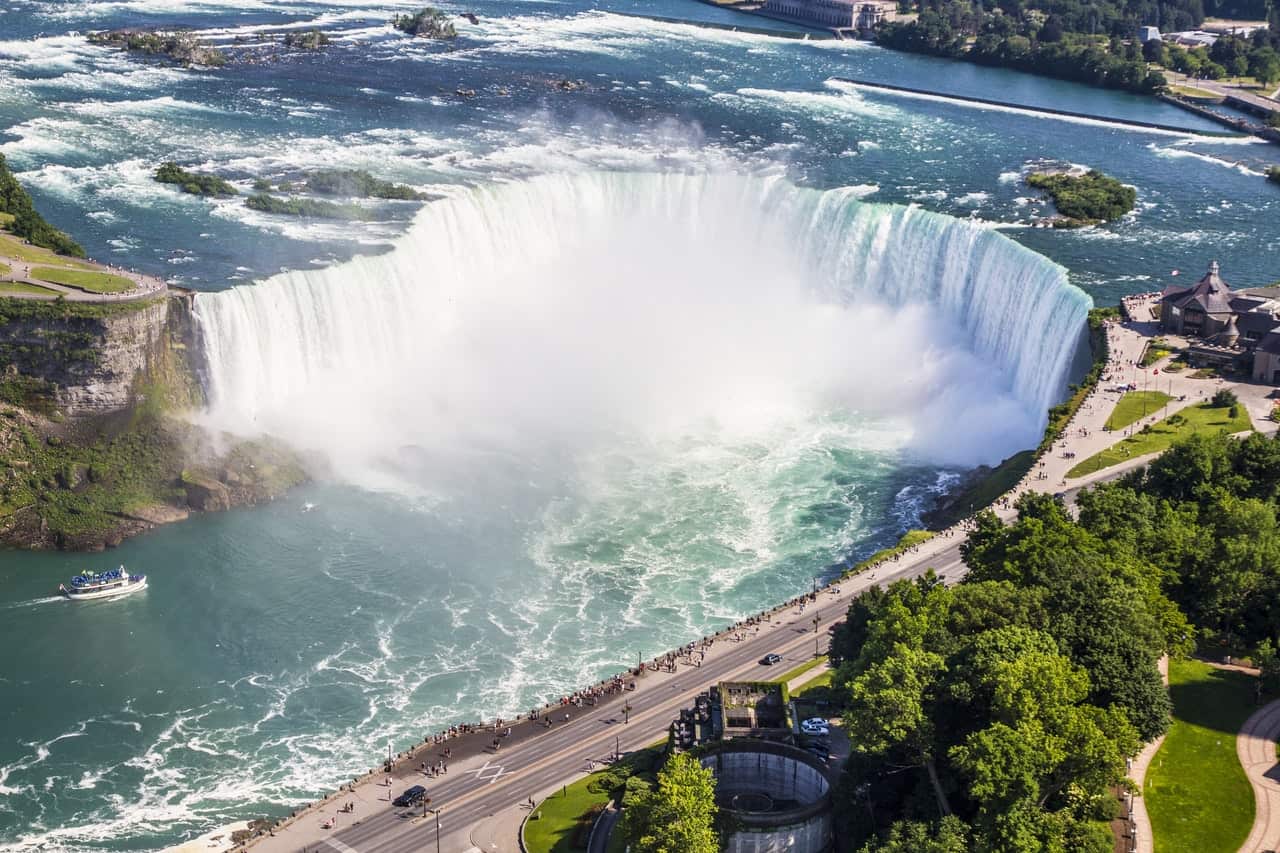
Many people in the past have attempted to conquer Niagara Falls and failed.
Since 1850, there have been records of more than 5,000 people going over Niagara Falls from both intentional and accidental means. Additionally, several people have also attempted to perform death-defying stunts, typically over tightropes, over Niagara Falls where the majority often fail and fall to their deaths.
Due to this common occurrence, the local government of Ontario has prohibited attempting stunts over Niagara Falls, with offenders facing arrest or fines up to USD 25,000. For several other safety precautions, the local government also prohibits swimming and going into the water of Niagara Falls.
Since the 1880s, Niagara Falls has been known as the Honeymoon capital of the world.
For over 200 years, Niagara Falls has been the traditional spot for celebrating honeymoons among newlyweds. Over the years, both Canadian and American couples have traveled the sight of Niagara Falls to celebrate their honeymoon for a romantic and memorable trip together.
Additionally, newlyweds may also receive a free Honeymoon Certificate issued by the Niagara Falls Mayor. These certificates can be claimed on any day of the week at the Ontario Tourist Information Center. How’s that for neat Niagara Falls facts?
Niagara Falls State Park has diverse wildlife living on its property.
The Niagara Falls State Park has several wild species that naturally live around the area of the park. These species include a large diversity of birds, squirrels, insects, fish, raccoons, foxes, rabbits, reptiles, mussels. All of these species are protected and continuously observed by park maintenance and crews.
While sightings of these animals are not guaranteed during your visit to the park, they can generally be spotted along with the networks of walking paths found throughout the area. Additionally, the Niagara River Corridor also supports numerous species in the park that have reached critical stages in their lives.
The flow of the American Falls was once completely stopped for months in 1969.
On June 12th, 1969, the American Falls stopped flowing for months due to a dam built across the Niagara River. Built with over 27,800 tons of rocks, this new structure diverted the water’s original route to Horseshoe Falls.
By November 1969, the dam was destroyed with the use of dynamite which allowed water to flow over American Falls once again. However, access to the area remained off-limits as it was believed that the site could collapse into the gorge at any given time.
One of the oldest surviving United States flags can be found at Old Fort Niagara.
This particular United States Flag has only 15 stars and 15 stripes on its body. The Fort Niagara flag is also said to have driven the defenders of Baltimore and inspired a new national song.
Originally, the US built Fort Niagara to protect the interests of New France in North America, which largely played an important role in the French and Indian War of 1754 to 1763. Today, Old Fort Niagara has been renovated and converted into the Fort Niagara State Park and Museum as a national historical landmark.
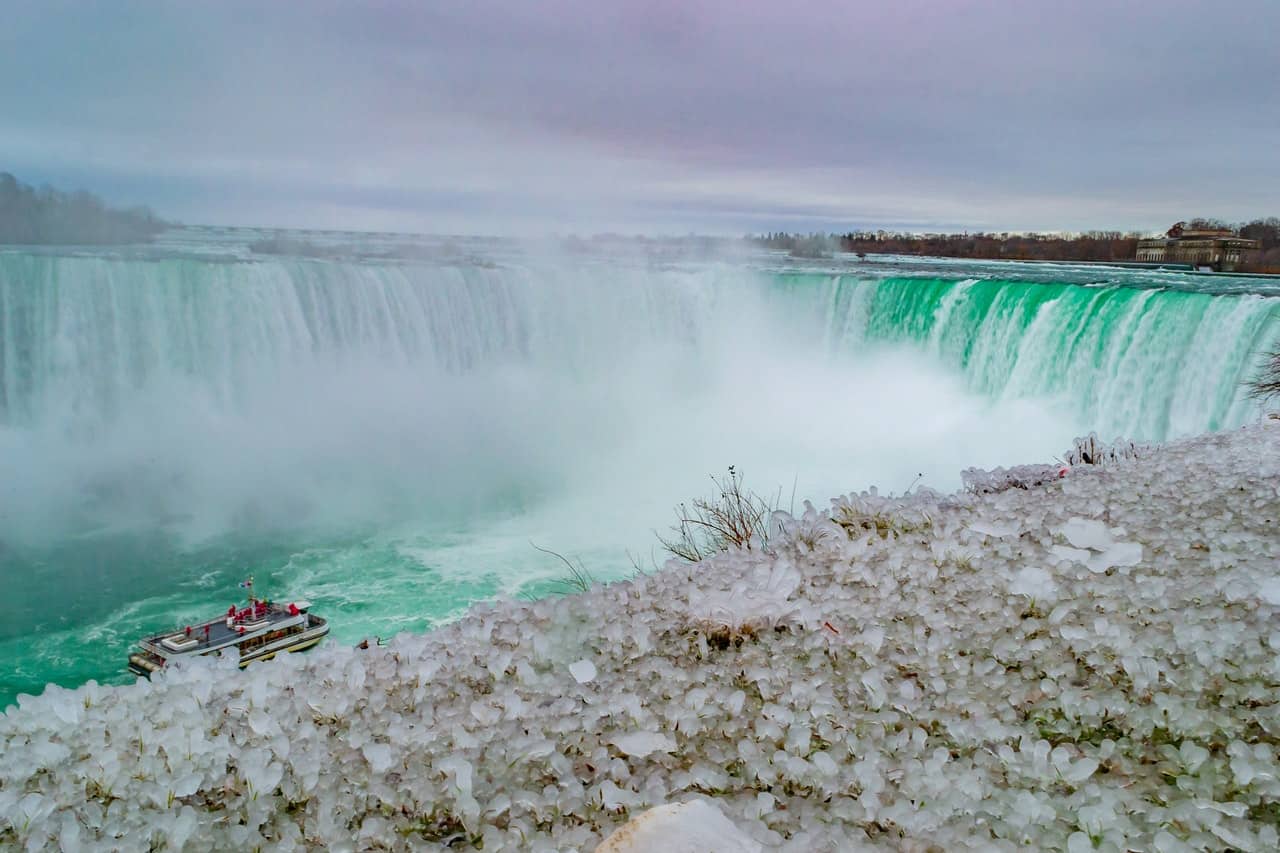
Over 700,000 gallons of water travel down Niagara Falls each second.
During the peak flow of Niagara Falls in the summer and autumn seasons, the landmark sends over 700,000 gallons of water flowing down Niagara Falls. Out of the three waterfalls at the location, the Bridal Veil Falls and the American Falls have the most amount of water flowing over it during the day.
Because of the powerful water flow is at Niagara Falls, it also serves as a good source for hydroelectric power which can also be redirected into cities nearby.
The first person to survive going over the Falls in a wooden barrel was a woman.
At 63 years old, Annie Edson Taylor attempted to go over Niagara Falls in a wooden barrel. At the time, Taylor stated that her motives were purely financial, in hopes that surviving the fall would grant her some money from the publicity alone.
However, in the end, she couldn’t collect a large wealth from this experience and instead attempted to write a novel about her experiences. Before her successful stunt, Annie Edson Taylor worked as a school teacher as a means of livelihood.
Niagara Falls is also home to the original Flight of Five Locks.
The Flight of Five Locks is a staircase lock located in the Erie Canal in Lockport, New York City, which was constructed to lift or lower the canal boat over the Niagara Escarpment. Mainly built by Scottish and Irish immigrants, this lock is also a part of the Erie Canalway National Heritage Corridor constructed between 1816 to 1825.
During the early years of its completion, many officials attempted to incorporate the Flight of Five Locks as part of the national tourist attraction that could be used to take day trips to Niagara Falls. Today, tourists can opt to take a short cruise through the more modern locks in Lockport city.
The Cave of the Winds found at Niagara Falls park is torn down and rebuilt annually.
The Cave of the Winds offers tourists and visitors of Niagara Falls an enjoyable experience with access to an observation deck and a close look at the history of the landmark. Additionally, elevators on the site can also take visitors 175 feet deep into the Niagara Gorge, where they can stand 20 feet away from the billowing torrents of the Bridal Veil Falls.
This experience also allows visitors to get as close to the falls as possible while maintaining safety protocols to ensure a memorable and fun time at the Niagara Falls State Park. Visitors may also have their photos taken during this experience to print and take home later on after the tour.
You can ride a boat to take a closer look at Niagara Falls for a small fee.
The Niagara Falls State Park offers many ways for visitors to come close to the three waterfalls as safely as possible. One of these methods can be attained by a boat ride that lasts approximately 30 minutes.
From the boat, visitors can experience the splash of the waterfalls and can also experience riding through a rainbow on some occasions. However, during strong weather, this option is typically closed down due to safety protocols followed by the staff of the State Park.
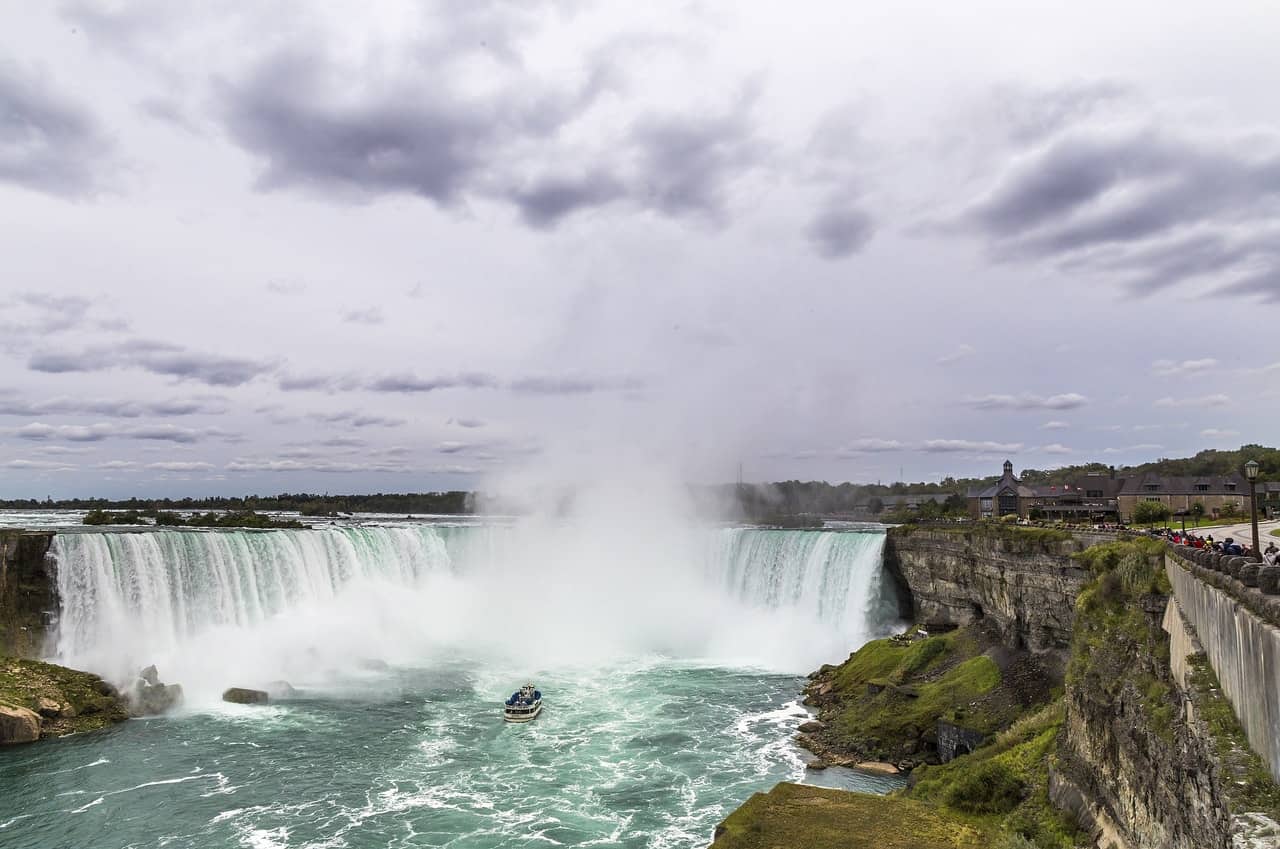
Before cameras were invented, several artists came to the site and sketched the landmark.
One of the most well-known works that depict Niagara Falls is the ‘Niagara Falls, From the American Side’ painting by the American artist Frederick Edwin Church. Based on preliminary sketches and sepia photographs that he took of the falls, Church completed the painting in 1876.
Generally, the painting depicts the East view of Niagara Falls along with the spray of a rainbow that highlights the constant flow of water down the falls. Today, the painting can be found at the Scottish National Gallery as Church’s largest painting.
The Niagara Falls State Park is the oldest state park found in the United States of America.
Open on all days of the year, visitors can come to see the grandeur of the falls at the Niagara Falls State Park all year round. Established in 1885, the Niagara Falls State Park has over 435 acres of land for visitors to explore and experience.
Additionally, this state park also offers several food concession stands, a museum, a gift shop, and a movie theatre for visitors to enjoy. There are also several picnic spots and hiking trails along the property that visitors can enjoy.
The power generation facilities near the property of the Niagara Falls supply power to both Canada and the United States.
Since 1882, there have been several hydroelectric power plants in the vicinity of Niagara Falls that provide electricity to Canada and the United States of America. Some of these hydroelectric power plants include the Electrical Development Company (EDC), the Ontario Power Company, as well as the Niagara River Hydraulic Tunnel Power and Sewer Company.
These hydroelectric power plants provide power not only for Niagara Falls State Park but to other cities within the borders of Canada and America as well. Additionally, these power plants can generate enough power for over 3.8 million homes in their respective vicinities.
Periods of peak flow that occur at Niagara Falls are during the summer months.
The power of the water drawn over Niagara Falls depends on two sole factors: the time of the year and the time of the day. Typically, the flow of water at Niagara Falls reaches its peak during the daytime from June to August, as the landmark has the highest average number of tourists around this time.
If they wish to stay more than a day at the Niagara Falls State Park, they can book hotels within the vicinity to enjoy the natural beauty of Niagara Falls. For accommodations, rates are typically lower during the winter months, right after peak season.
Around 20% of drinking water in the United States comes from Niagara Falls.
This totals to around one-fifth of the drinking water sourced in the United States. Additionally, the surrounding Great Lakes also make up around 84% of North America’s surface freshwater.
The water from Niagara Falls first goes through a treatment facility, which filters the water of bacteria, parasites, and purifies it for drinking. As such, it is not advised that people directly drink water from Niagara Falls itself without being treated first in the proper facilities.
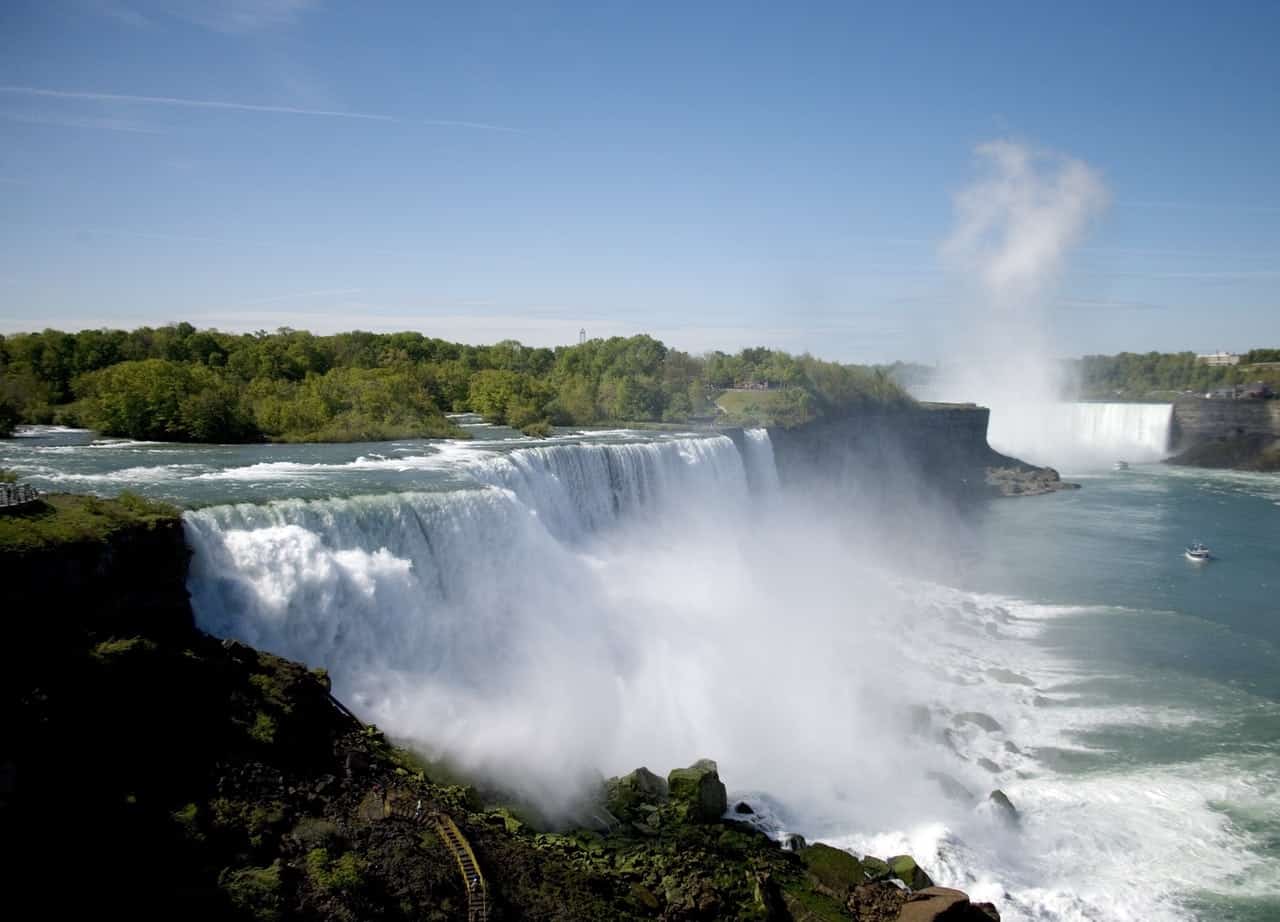
Around 50% of the water that flows along the Niagara River is diverted to hydroelectric power stations.
The power plants at Niagara Falls put out around 4.9 million kilowatts of electricity to power cities in nearby territories. Hydroelectric power plants on the borders of the United States generally have a capacity of around 2.7 million Kilowatts while the other power plants on the Canadian side has a capacity of around 2.2 million Kilowatts.
Much of the river is diverted into pipes that lead towards the hydroelectric power stations where the water is sent into large turbines that generate the water into electricity.
Niagara Falls State Park has a special movie theatre that visitors can access.
Apart from the magnificent view of the landmark, the Niagara Falls State Park also offers several recreational activities for visitors to try during their stay. These activities include a zipline ride, a helicopter tour, fishing trips, hiking trips, jet boat tours, park shows, and many more.
There are also several food concession stands and restaurants around the area, as well as a full golf course. Lastly, visitors can also enjoy their stay in nearby hotels and casinos that also provide additional amenities and experiences during their stay at the state park.
The Niagara Falls State Park offers a variety of fun activities for visitors of all ages.
Apart from taking in the magnificent view of the landmark, the Niagara Falls State Park also offers a number of recreational and many fun activities for visitors to try during their stay. These include a zipline ride, a helicopter tour, fishing trips, hiking trips, jet boat tours, park shows, and many more.
There are also a number of food concession stands and restaurants around the area and a full golf course. Lastly, visitors can also enjoy their stay in the nearby hotels and casinos that also provide additional amenities and experiences during their stay at the state park.
Niagara Falls has existed over 12,000 years ago.
Researchers have stated that the formation of Niagara Falls can be dated back to the time of the Ice Age, where large torrents of water emerged from the melting ice at the end of its era. This water eventually drained out to Niagara Falls, which was later on discovered by a French explorer in 1678.
Over time, Niagara Falls has been noted to move upstream and slowly turned into the shape of a horseshoe, hence one of the falls being named Horseshoe Falls. Apart from being an iconic location during the French and Indian War, Niagara Falls also became the birthplace of hydroelectric power in 1896 which was developed by Nikola Tesla.
The Niagara Falls Association preserves the natural beauty of the landmark.
Because the landmark lies between the two borders of Canada and the United States of America, both countries have created organizations to maintain its natural formation. The operating costs of the Niagara Falls State Park are funded by visitations and fees collected from several attractions throughout the park.
Apart from maintaining the operations of the area, the park also looks after the wildlife that lives in the surrounding area and forbids hunters from harming their protected species.
Was this page helpful?
Our commitment to delivering trustworthy and engaging content is at the heart of what we do. Each fact on our site is contributed by real users like you, bringing a wealth of diverse insights and information. To ensure the highest standards of accuracy and reliability, our dedicated editors meticulously review each submission. This process guarantees that the facts we share are not only fascinating but also credible. Trust in our commitment to quality and authenticity as you explore and learn with us.
